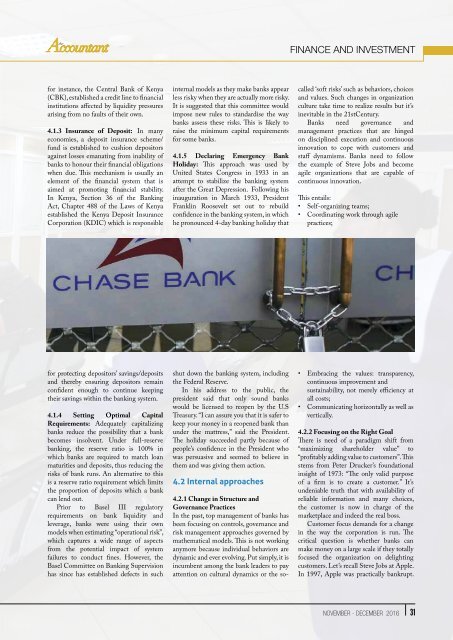The Accountant Nov-Dec 2016
You also want an ePaper? Increase the reach of your titles
YUMPU automatically turns print PDFs into web optimized ePapers that Google loves.
Finance and Investment<br />
for instance, the Central Bank of Kenya<br />
(CBK), established a credit line to financial<br />
institutions affected by liquidity pressures<br />
arising from no faults of their own.<br />
4.1.3 Insurance of Deposit: In many<br />
economies, a deposit insurance scheme/<br />
fund is established to cushion depositors<br />
against losses emanating from inability of<br />
banks to honour their financial obligations<br />
when due. This mechanism is usually an<br />
element of the financial system that is<br />
aimed at promoting financial stability.<br />
In Kenya, Section 36 of the Banking<br />
Act, Chapter 488 of the Laws of Kenya<br />
established the Kenya Deposit Insurance<br />
Corporation (KDIC) which is responsible<br />
internal models as they make banks appear<br />
less risky when they are actually more risky.<br />
It is suggested that this committee would<br />
impose new rules to standardise the way<br />
banks assess these risks. This is likely to<br />
raise the minimum capital requirements<br />
for some banks.<br />
4.1.5 <strong>Dec</strong>laring Emergency Bank<br />
Holiday: This approach was used by<br />
United States Congress in 1933 in an<br />
attempt to stabilize the banking system<br />
after the Great Depression. Following his<br />
inauguration in March 1933, President<br />
Franklin Roosevelt set out to rebuild<br />
confidence in the banking system, in which<br />
he pronounced 4-day banking holiday that<br />
4.2.1 Change in Structure and<br />
Governance Practices<br />
In the past, top management of banks has<br />
been focusing on controls, governance and<br />
risk management approaches governed by<br />
mathematical models. This is not working<br />
anymore because individual behaviors are<br />
dynamic and ever evolving. Put simply, it is<br />
incumbent among the bank leaders to pay<br />
attention on cultural dynamics or the socalled<br />
‘soft risks’ such as behaviors, choices<br />
and values. Such changes in organization<br />
culture take time to realize results but it’s<br />
inevitable in the 21stCentury.<br />
Banks need governance and<br />
management practices that are hinged<br />
on disciplined execution and continuous<br />
innovation to cope with customers and<br />
staff dynamisms. Banks need to follow<br />
the example of Steve Jobs and become<br />
agile organizations that are capable of<br />
continuous innovation.<br />
This entails:<br />
• Self-organizing teams;<br />
• Coordinating work through agile<br />
practices;<br />
for protecting depositors’ savings/deposits<br />
and thereby ensuring depositors remain<br />
confident enough to continue keeping<br />
their savings within the banking system.<br />
4.1.4 Setting Optimal Capital<br />
Requirements: Adequately capitalizing<br />
banks reduce the possibility that a bank<br />
becomes insolvent. Under full-reserve<br />
banking, the reserve ratio is 100% in<br />
which banks are required to match loan<br />
maturities and deposits, thus reducing the<br />
risks of bank runs. An alternative to this<br />
is a reserve ratio requirement which limits<br />
the proportion of deposits which a bank<br />
can lend out.<br />
Prior to Basel III regulatory<br />
requirements on bank liquidity and<br />
leverage, banks were using their own<br />
models when estimating “operational risk”,<br />
which captures a wide range of aspects<br />
from the potential impact of system<br />
failures to conduct fines. However, the<br />
Basel Committee on Banking Supervision<br />
has since has established defects in such<br />
shut down the banking system, including<br />
the Federal Reserve.<br />
In his address to the public, the<br />
president said that only sound banks<br />
would be licensed to reopen by the U.S<br />
Treasury. “I can assure you that it is safer to<br />
keep your money in a reopened bank than<br />
under the mattress,” said the President.<br />
<strong>The</strong> holiday succeeded partly because of<br />
people’s confidence in the President who<br />
was persuasive and seemed to believe in<br />
them and was giving them action.<br />
4.2 Internal approaches<br />
• Embracing the values: transparency,<br />
continuous improvement and<br />
sustainability, not merely efficiency at<br />
all costs;<br />
• Communicating horizontally as well as<br />
vertically.<br />
4.2.2 Focusing on the Right Goal<br />
<strong>The</strong>re is need of a paradigm shift from<br />
“maximizing shareholder value” to<br />
“profitably adding value to customers”. This<br />
stems from Peter Drucker’s foundational<br />
insight of 1973: “<strong>The</strong> only valid purpose<br />
of a firm is to create a customer.” It’s<br />
undeniable truth that with availability of<br />
reliable information and many choices,<br />
the customer is now in charge of the<br />
marketplace and indeed the real boss.<br />
Customer focus demands for a change<br />
in the way the corporation is run. <strong>The</strong><br />
critical question is whether banks can<br />
make money on a large scale if they totally<br />
focused the organization on delighting<br />
customers. Let’s recall Steve Jobs at Apple.<br />
In 1997, Apple was practically bankrupt.<br />
NOVEMBER - DECEMBER <strong>2016</strong> 31


















